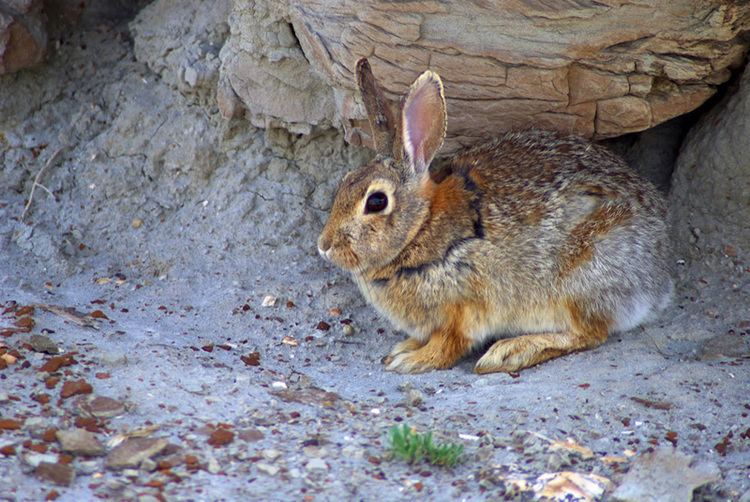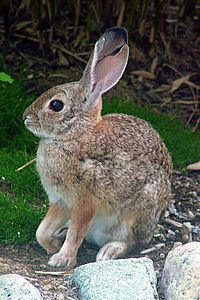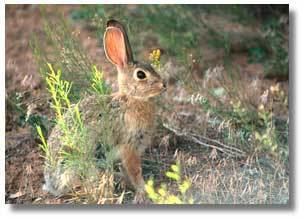Kingdom Animalia Order Lagomorpha Genus Sylvilagus Higher classification Cottontail rabbit | Phylum Chordata Family Leporidae Scientific name Sylvilagus audubonii Rank Species | |
 | ||
Similar Cottontail rabbit, Black‑tailed jackrabbit, Mammal, Mountain cottontail, Eastern cottontail | ||
Desert cottontails at the springs preserve
The desert cottontail (Sylvilagus audubonii), also known as Audubon's cottontail, is a New World cottontail rabbit, and a member of the family Leporidae.
Contents
- Desert cottontails at the springs preserve
- Desert cottontail rabbit
- Lifespan
- Eating mechanics
- References

The desert cottontail is found throughout the western United States from eastern Montana to western Texas, and in northern and central Mexico. Westwards its range extends to central Nevada and southern California and Baja California. It is found at heights of up to 2,000 m (6,600 ft). It is particularly associated with the dry near-desert grasslands of the American southwest; though it is also found in less arid habitats such as pinyon-juniper forest.

The desert cottontail is quite similar in appearance to the European rabbit, though its ears are larger and are more often carried erect. It is also social among its peers, often gathering in small groups to feed. The desert cottontail uses burrows made by rodents rather than making its own. Like all cottontail rabbits, the desert cottontail has a rounded tail with white fur on the underside which is visible as it runs away. It is a light grayish-brown in color, with almost white fur on the belly. Adults are 33 to 43 cm (13 to 17 in) long and weigh up to 1.5 kg (3.3 lb). The ears are 8 to 10 cm (3.1 to 3.9 in) long, and the hind feet are large, about 7.5 cm (3.0 in) in length). There is little sexual dimorphism, but females tend to be larger than the males, but have much smaller home ranges, about 4,000 square metres (1 acre) compared with about 60,000 square metres (15 acres) for a male.

The desert cottontail is not usually active in the middle of the day, but it can be seen in the early morning or late afternoon. It mainly eats grass, but will eat many other plants, herbs, vegetables and even cacti. It rarely needs to drink, getting its water mostly from the plants it eats or from dew. Like most lagomorphs, it is coprophagic, re-ingesting and chewing its own feces: this allows more nutrition to be extracted.

Many desert animals prey on cottontails, including birds of prey, mustelids, the coyote, the bobcat, the lynx, wolves, mountain lions, snakes, weasels, humans, and even squirrels, should a cottontail be a juvenile, injured or docile. Southwestern Native Americans hunted them for meat but also used their fur and hides. The cottontail's normal anti-predator behavior is to run away in evasive zigzags; it can reach speeds of over 30 km/h (19 mph). Against small predators or other desert cottontails, it will defend itself by slapping with a front paw and nudging; usually preceded by a hop straight upwards as high as two feet when threatened or taken by surprise.

The young are born in a shallow burrow or above ground, but they are helpless when born, and do not leave the nest until they are three weeks old. Where climate and food supply permit, females can produce several litters a year. Unlike the European rabbit, they do not form social burrow systems, but compared with some other leporids, they are extremely tolerant of other individuals in their vicinity.
Desert cottontail rabbit
Lifespan
The lifespan of a cottontail averages about two years, depending on the location. Unfortunately for the cottontail, almost every living carnivorous creature larger or faster than the Lagomorph is its predator. Cottontail lagomorphs borrow burrows that have been vacated by other animals. Some predators, like snakes for example, are well aware of the local real estate used and reused by the cottontails, and make a meal of the young at will, with little or no resistance by the mother rabbit. She is defenseless against any and all that would get close enough to eat her or her young. Though cottontails are very sexually active creatures, and mated pairs have several offspring many times in all seasons, it is more likely than not that none will survive to adulthood. Those that do manage to avoid being eaten, grow very quickly and are considered full grown adults at three months.
Eating mechanics
Unlike the squirrel and chipmunk that eat sitting up on their hind legs and can hold food with their front paws, while spinning it in circles to devour it quickly, the desert cottontail, like all cottontails, eats on all fours. It can only use its nose to move and adjust the position of the food that it places directly in front of its front paws on the ground. The cottontail rabbit will turn the food with its nose to find the cleanest part of the vegetation (free of sand and inedible parts) to begin its meal. The only time a cottontail uses its front paws to enable eating is when vegetation is above its head on a living plant. The cottontail will lift its paw to bend the branch to bring the food within reach.
Cottontails are rarely found out of their burrows looking for food on windy days, because the wind interferes with their hearing capabilities. Hearing an oncoming predator is their primary defense mechanism.
